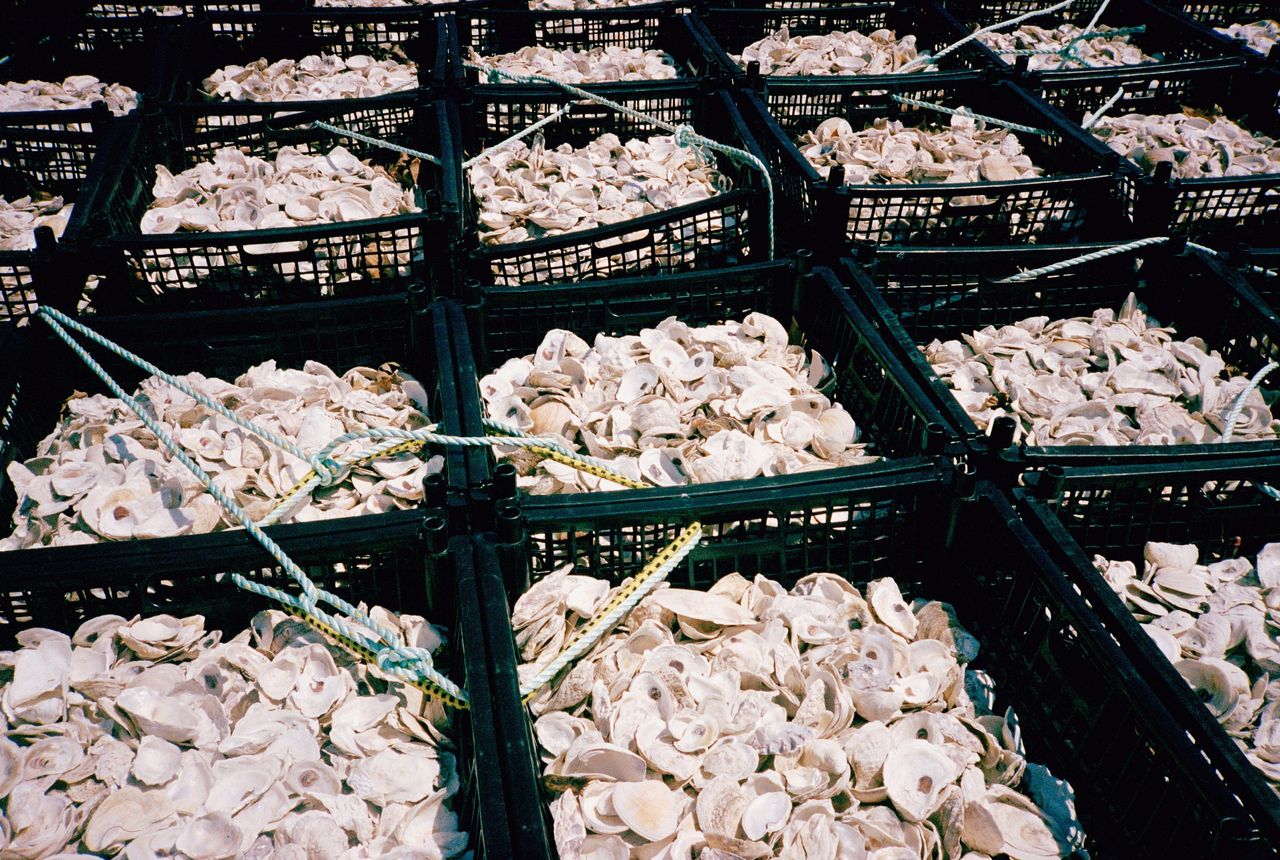As morning rose on New York’s Upper West Side, neighbors grew suspicious of workers tossing trash into bins in an alleyway nearby. They reeked of an odor that skunks would find offensive and felt like a threat to humankind. Soon, one neighbor called the health department.
Is it a secret society? A drug operation?
No. It was oyster shells.
The large bins were brimming with hard, brown, teardrop-shaped shells, once home to slimy gray sea creatures that now resided in the bellies of hundreds of seafood lovers who’d visited Crave Fishbar.
A local nonprofit, Billion Oyster Project, was scheduled to come pick them up and haul them off for recycling. For Crave owner Brian Owens , that means he gets the satisfaction of knowing he’s helping restore New York’s waterways . He’s also saving money for his restaurant, since recycling the shells cuts down on what he has to pay for trash collection.
“We shuck, you slurp, we recycle,” said Owens.
For people who don’t eat, yearn or dream about oysters, they are shellfish—similar to clams and mussels—that are often consumed as an appetizer.
In lots of restaurants and households, the ugly shells just get tossed in the trash afterward. But when they’re properly recycled, they can become the foundation for oyster reefs that provide habitat to marine life, reduce flooding and protect shorelines from big storms.
Owens says that Crave used to throw away more than 375,000 shells a year. Now, most of those shells are repurposed. Still, a huge number of oyster shells continue to end up in the trash, despite shell-recycling programs scattered throughout the U.S. , both East and West coasts.
Things can get smelly
Some restaurants set 32-gallon bins in the middle of their eateries for customers to toss their shells once they’re done, or post signs urging “No Shell Left Behind.” Others rely on their dishwashers to pluck them from dirty plates.
Shell-recycling nonprofits tend to retrieve bins from participating restaurants, and some also set up bins around a community for local residents. Afterward, the oyster shells are washed and set outside in the sun for several months to kill bacteria before being placed back into local waterways.
Many restaurants aren’t aware recycling programs exist. Getting them on board can be a challenge, some nonprofit managers said. After all, nobody likes the fishy smell of a pile of oyster shells.
Shell recyclers view the task with the utmost importance. Overharvesting, disease and pollution have killed off a number of oyster reefs.
Shuck to buck
Extra pocket money can be a good motivator. Owens, the Crave owner in New York, said he has saved about $10,000 on trash pickup since he began recycling oyster shells eight years ago.
Louisiana offers tax incentives to restaurants that don’t toss their shells in the garbage. Coalition to Restore Coastal Louisiana said it has recycled almost 14 million pounds of oyster shells since 2014.
“It’s just such a win-win situation,” said Sonya DiCarlo , co-owner of Clesi’s Restaurant & Catering in New Orleans. “Any opportunity that we have to have tax credits, it’s just a wonderful thing.”
Louisiana’s tax credit went into effect in January, allowing restaurants recycling with approved nonprofits to receive $1 per 50 pounds of oyster shells, to a maximum of $2,000. The tax credit caps at $100,000 on a first-come, first-served basis.
Nick Schauman , owner of The Local Oyster, a Baltimore catering company, has been recycling oyster shells for a decade, a process he started when his business was mostly a folding table, a boombox and a cooler of Pabst Blue Ribbon.
Maryland for some years has offered a shell-recycling tax credit of up to $1,500. The state recently approved a grant program where restaurants will receive a check for up to $2,000.
“We’ve always maxed out our credits over the years,” Schauman said. “But a $2,000 check I think would be more helpful.”
Clearing the air
Billion Oyster Project has campaigned for New York to start a $1,000 tax credit for restaurants that recycle shells, but it hasn’t been successful.
“I do think it’s important to make sure the restaurants understand and know that we support them,” said Charlotte Boesch , shell-collection program manager at Billion Oyster Project, which has collected over 2.5 million pounds of recycled shells since 2014. “I think for the restaurants, it’s really valuable, although the tax credit is fairly minimal.”
Tax credit or not, there’s no easy way to turn a bunch of empty oyster shells into a new reef.
Billion Oyster Project said it collects shells from 75 restaurants four days a week and hauls them over to Fulton Fish Market Cooperative in the Bronx. They store the shells in dumpsters in a fenced-off area of the parking lot.
The shells are then moved to Governors Island once a month. There, they cure for one year. Oyster larvae are introduced, and they settle onto the shells. The shells re-enter local waters afterward.
Prince William visited in September, examining the piles of drying shells and even wading into the East River.
And as for Owens, the owner of Crave in New York City? He spends some time each evening making sure the words “Billion Oyster Project” plastered across his bins are visible to any worried bystanders.
Write to Kailyn Rhone at kailyn.rhone@wsj.com



